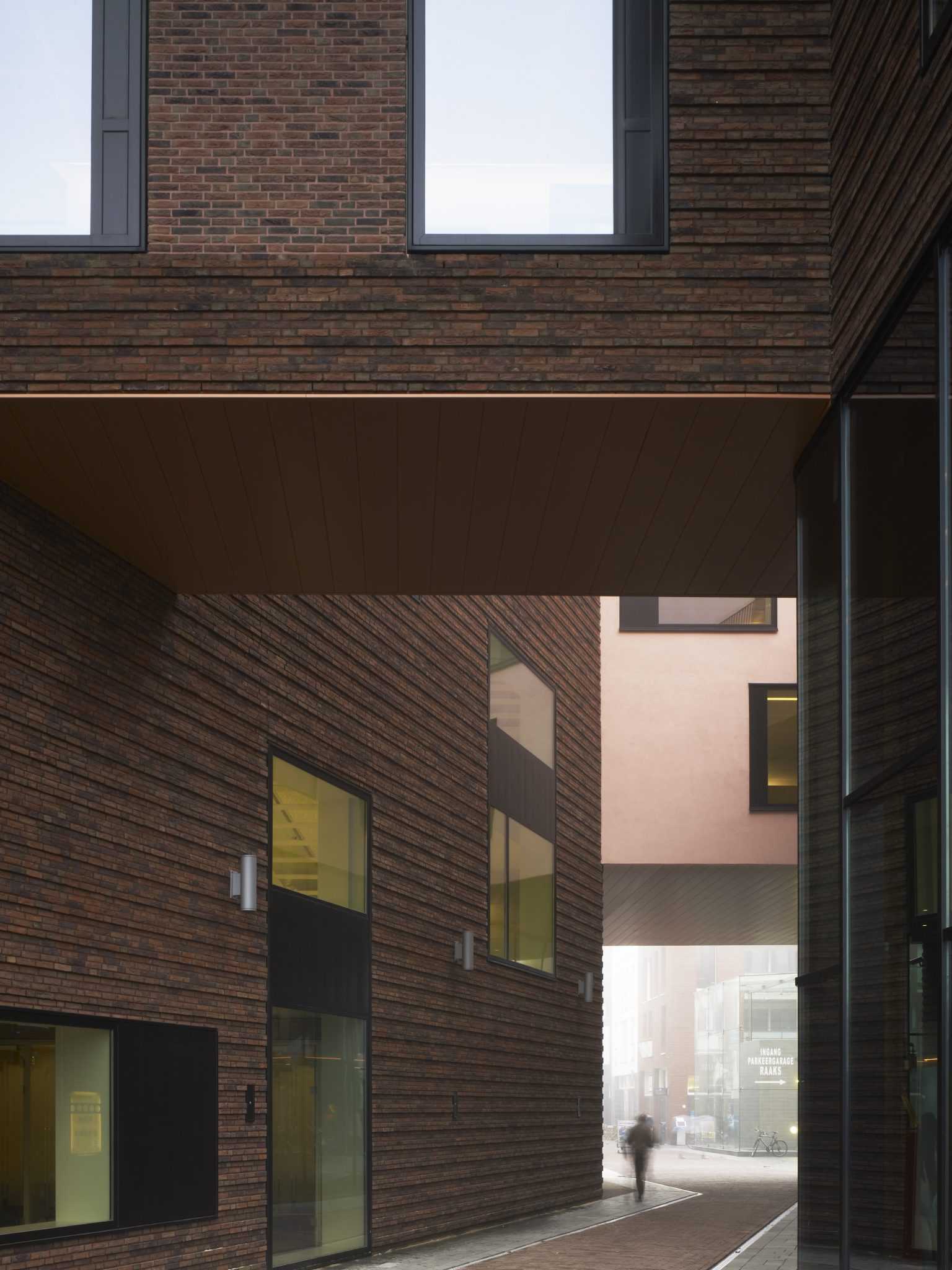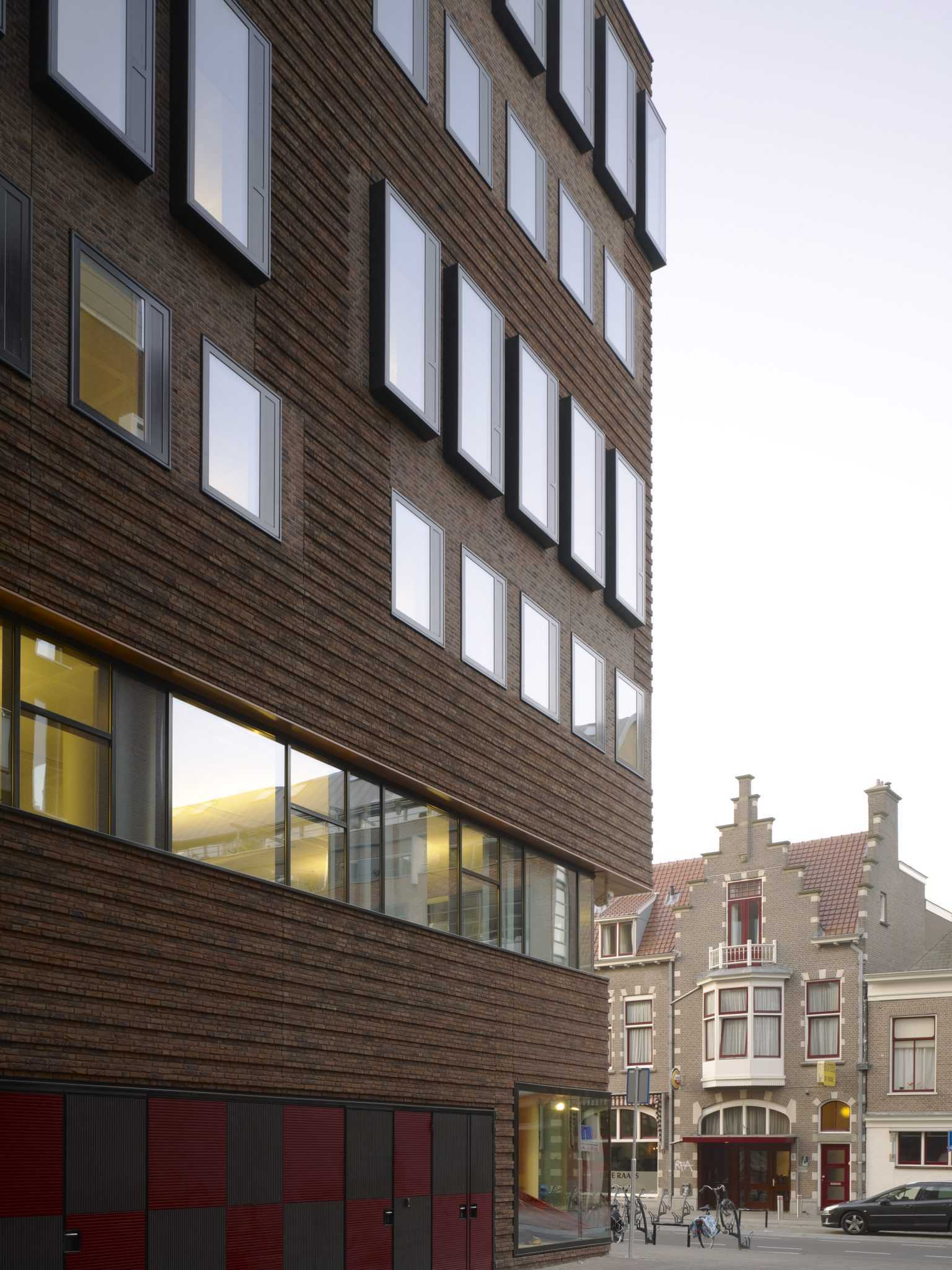
St. Sebastian
TYPOLOGY: Educational
COUNTRY: Germany
CITY Münster
YEAR: 2013
COMPETITION: 2009, 1st Prize
PHOTOS: © Markus Hauschild, Christian Richters
HISTORICAL PHOTO: © S. Ahlbrand-Dornseif, R.Wakonigg
A church becomes a kindergarten.
Not heritage listed, already condemned, the St. Sebastian church built in 1962 and deconsecrated in 2008 has been revitalized with the most lively and positive function, i.e. with children.
The elegant elliptical form of the nave physically anchors its surrounding neighborhood. Two levels of kindergarten group rooms are housed within, the roofs of these become an all-weather play deck. Grass green impact-protection flooring and street lights give the play decks the ambience of an outdoor space.
A grid of 50 x 50 cm unglazed openings, the only originally glazed light source in the church, provide constant, natural ventilation. Cold in winter, comfortably temperate in summer, but always dry, this magical inside/outside space is flooded with light.
Adjacent to the kindergarten nave, a new street facing extension houses the main entrance, kitchen, offices, technical rooms and one multipurpose room. This is available for neighborhood events.



















U Boat Hall
TYPOLOGY: Retail
COUNTRY: Germany
CITY: Hannover
YEAR: 2012
CLIENT: RS Möbelhandelsgesellschaft mbH
PHOTOS: © Olaf Mahlstedt
LOCKED IN SERVITUDE THE DRAMA OF A BUILDING’S MAKING REMAINS HIDDEN: (Louis Kahn)
There is today an enormous potential in the re-scripting of grand industrial spaces, survivors from an epoch that had less trouble expressing itself and its mechanical or technical potency than our current mean and exploitative ‘global shopping-centre-culture’.
One thinks of São Paulo’s Fábrica da Pompéia by Lina Bo Bardi, London’s Tate Bankside, or the Zollverein Coal Mine in Essen, Germany.
This was our first reaction as our client drove his black Porsche into the rusting cathedral of Hannover’s ‘U-boat Hall’. Was it a panic reaction at the end of WW II to build a submarine production space so far from the North Sea? The structure of the hall had in fact been originally designed for a U-boat production site of a naval dockyard in Wilhelmshaven. As it turned out the enigmatically named ‘U-boat Hall’ was only finished in 1944 and was thus not used for armament production.
Now sliced like salami the ‘Industrial Heritage Structure’ is to house various commercial outlets – a mega Bicycle Emporium where racing bikes can be tested in the shop or this landscape of coloured furniture.
This is in fact two shops; RS (wholesome wood) and Yellow (sub-designer). BOLLES+WILSON have already realized their flagship store in Münster and the HQ Building, a rooftop lake above a ‘big box’ two-floor warehouse/distribution centre.
For the ‘U-boat Hall’ the rent was based on the square meters of the hall’s floor. The architectural question was how to maximize this floor area with a selling landscape and a back of house warehouse for customers to pick up their new sofa / table / lamp.
The magnificent scale of rusting columns, elevated crane track and skylight box, resist the invasion of domestic equipment, relegating it to the status of ‘a carpet of coloured pixels’ spread across the selling decks.










Raakspoort
Raakspoort – City Hall and Bioscoop
TYPOLOGY: Office / Leisure
COUNTRY: The Netherlands
CITY: Haarlem
YEAR: 2011
GFA: 18.500 sqm
CLIENT: MAB Development Nederland B.V.
AWARDS: NRW Jaarprijs, Best Retail Development, NL, 2013
Brick Award, Worldwide Brick, GB, 2012
PHOTOS: © Christian Richters
Transformative processes, particularly those relating to delicate fine-grained historic cities like Haarlem are complex and protracted. In the case of the Raaks project it took more than ten years to evolve from the considered Urban Masterplan (Donald Lambert – Kraaijvanger Urbis) through a sequence of workshops and program rethinks to the final ensemble, which opened in October 2011.
At the outset BOLLES+WILSON were given responsibility for the outermost block of this close packed, highly urban redevelopment precinct – which as it turns out (and as the masterplan prescribed) intertwines almost seamlessly with the adjacent small-scale urban fabric – a neighbourhood. The edge block must both shield (traffic) and invite (pedestrians), it must signal and respectfully take its place in the sequence of facades that define the historic limit of the medieval city. Initiating site workshops brought together neighbourhood representatives, city representatives, developers and architects – BOLLES+WILSON, Claus en Kaan, Jo Crepain and Kraaijvanger Urbis (who also had responsibility for the large format carpark below).
The complex functional mix began with one large and seven smaller Cinemas on the upper levels, a subterranean Casino and below that a parking deck (for croupiers and gamblers). Even at this stage the two functions were divided by a bisecting passage leading from the visible and representative outside facade to the networked block interior. The question of scale and historic referencing of the windowless















Inselpark Entrance Complex
TYPOLOGY: Office, Residential
COUNTRY: Germany
CITY: Hamburg
YEAR: 2013
COMPETITION: Invited Competition 2011, First Prize
PHOTOS: © Markus Dorfmüller, Johanna Klier
The masterplan required two towers to mark the entrance to the Garden Show and Building exhibition. The big-brother of the pair, the giant, striped (Jacobs-coat) Sauerbruch and Hutton building, a new hive for Hamburg’s Planning Department (BSU) was not, according to the competition brief, to be upstaged by its neighbour. Already at the outset the bumpy road forward was in evidence when the black facade (no competition for polychromy) of the premiated BOLLES+WILSON entry was rejected by the developers of the railway-track side of the same block – not the right statement for their housing for the elderly. The facade mutated to green. “No green”, said the same developer, green is the colour of their chairman’s football team’s archrivals. The architects insisted that football allegiances is not a credible basis for urban planning decisions, and supported by the ubiquitous director of planning, the corner tower remained green. To get planning approval the developers were caused to sign a commitment that the green ceramic façade, a thematicised official entry to the Garden Show, would not be compromised during planning and construction. A wise requirement as fast track planning was necessitated by delays due to wobbly project financing around 2011. Further down the track a rapid rethink of the green facade was again necessitated by ‘just-in-time’ scheduling. The planed gluing of the rippled ceramic tile stripes would have to happen in winter (sub zero temperatures render glues impotent). A dry system of hung ceramic panels was at the last minute chosen and the respectfully stepping facade arrived as the IBA building exhibition opened.
The 9-floor tower is a medical centre, highly installed individual doctors rooms. Apartments and duplex penthouses with sculptural cut-out balconies occupy the top three floors. A darkening of the green ceramic facade signals a separate function for the four-floor wing to the south. This is the InselAkademie promoting sport for teenagers – not only from the surrounding Wilhelmsburg dockland district, characterised by social housing, immigration and unemployment. The upper floors of the InselAkadamie are group apartments for sporting youth and the lower two floors seminar and the temporary administration rooms of the IBA (International Building Exhibition). This building is in fact the hub of the IBA and also post IBA activities.











Cologne-Muelheim Harbour District
TYPOLOGY Masterplan
COUNTRY: Germany
CITY: Cologne
YEAR: 2013 – (2015)
COMPETITION: 2013, dialogic planning process
‘Werkstattverfahren Mülheim Süd Inkl. Hafen’
CLIENT: Stadt Köln
After a dialogic planning process in 2013, the two competing planning teams around kister scheithauser gross (Cologne) and BOLLES+WILSON have teamed up for the next planning stage. The development of Mülheim’s harbour district is still an on-going process integrating various interests and disciplines. The masterplan for this 52 ha harbour area preserves various grand industrial spaces to create a new district with a unique character and atmosphere.










